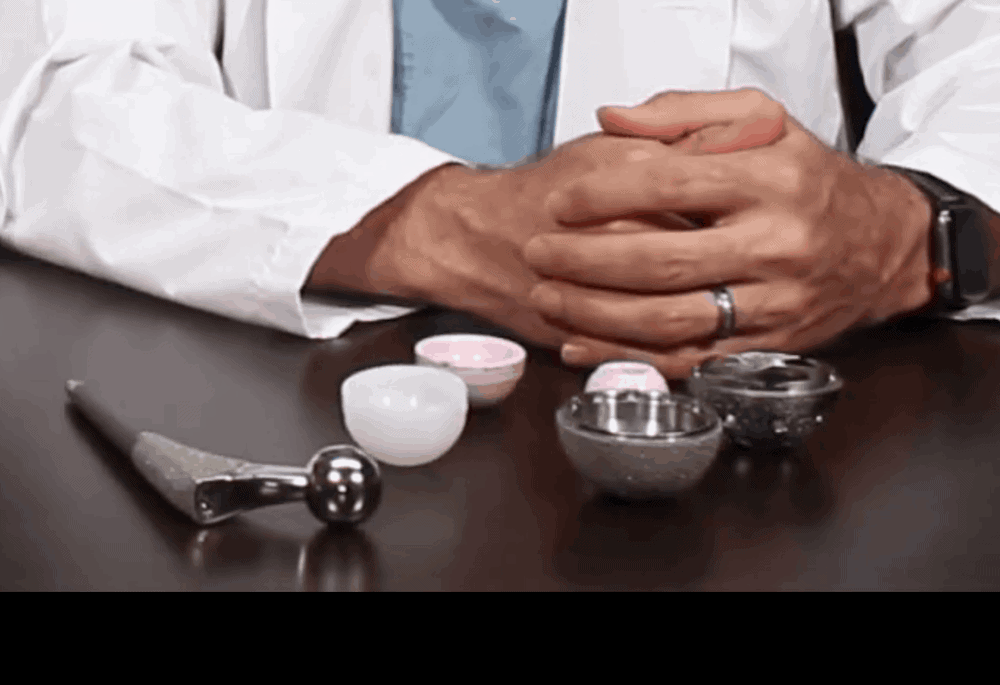
[Image above] Example of prosthetic implants used for total hip replacement. Bacterial growth on implant surfaces can lead to infection and serious complications, so some researchers are exploring the use of nanotechnology for prevention and treatment. Credit: Talking With Docs, YouTube
In recent decades, the number of people receiving total joint replacements has increased substantially as the technologies for such surgeries have matured and average life expectancy has increased. Yet along with the increasing number of implantations is an increasing number of cases of periprosthetic joint infection (PJI).
PJI is a serious complication occurring in 1–2% of primary joint replacement surgeries and in 4% of revision joint replacement surgeries. It is an infection involving the joint prosthesis and adjacent tissue and is caused by bacteria—usually Staphylococcus aureus—colonizing on the implant surface and forming a biofilm. (The bacteria can either be already present in the body or introduced during the surgery itself or subsequent procedures.)
Managing PJI can require complex treatment strategies, including multiple surgical revisions and long-term antimicrobial treatment. However, doctors generally agree that isolation or identification of the causative microorganism represents the main determinant for success in PJI treatment.
Nanotechnology is an emerging area of interest for orthopedic surgeons looking to treat PJI. In addition to nanomaterials offering unique electrical and mechanical properties that improve interaction with the surrounding environment, creation of drug-loaded nanomolecules allows for antibiotic therapy to directly target the infection-causing microorganisms.
To date, the clinical impact of nanotechnology in PJI prevention and treatment is very limited. The potential for this treatment is appealing enough, though, that it drove a team of researchers in Italy and the United States to write an open-access review paper on this application of nanotechnology.
The authors come from Stanford University School of Medicine, Sapienza University of Rome, and Vita-Salute San Raffaele University. While they acknowledge this research is still in its infancy, they argue that the current research is promising enough to support funding of more extensive basic science and clinical research.
Prevention of PJI
Because PJI involves bacterial colonization on the implant surface, the material used for the implant can play a substantial role in preventing PJI.
Modern implants typically consist of a mixture of titanium, cobalt-chrome, ceramic, and vitamin-E-stabilized ultrahigh-molecular weight polyethylene. To prevent bacterial growth on these surfaces, the authors note silver nanoparticles reduce cell viability, and nanosilver coatings can be easily incorporated into hydroxyapatite and chitosan to reproduce an antibacterial coating with osteointegrative capability.
“However, current methods of nanosilver synthesis are based on the use of organic solvents and stabilizers that are potentially toxic to the environment, and, thus, the green synthesis of silver nanoparticles should become a prerequisite for the development and application processes of nanotechnology,” they write.
Patients undergoing total joint replacement surgery are routinely administered antibiotics to prevent postoperative PJI. However, this practice faces multiple disadvantages, including increasing antibiotic resistance and the inability of antibiotics to disrupt already existing biofilms. Instead, the authors describe several antimicrobial nanoparticle alternatives that were engineered to prevent infections in orthopedic surgery.
Treatment of PJI
The authors explain that recent literature from the International Consensus Meeting on Orthopedic Infections confirms that many contemporary conservative measures for treating PJI, including the North American “gold standard” treatment of using a temporary polymethylmethacrylate cement spacer to deliver antibiotics, can fail to eradicate the biofilm from the periprosthetic environment.
Fortunately, multiple efforts to improve the structural and antibiofilm characteristics of the cement spacers are underway, notably ones that use various nanoparticles as antibiotic carriers.
“Interestingly, nanoparticles have demonstrated the capability of enhancing antibiotic penetration within a well-matured biofilm in multiple in vitro studies: multiple interaction mechanisms between nanoparticles and viable bacterial cells have been described, all resulting in bacterial cell death within the biofilm,” they write. “Unfortunately, in vivo studies are limited and it is unclear how antibiotic-delivery nanoparticles interact with biofilms in vivo.”
The authors note that recent studies have paid particular attention to the many derivates of graphene—including multilayer graphene, graphene oxide, and reduced graphene oxide—because of their mechanical and antimicrobial properties. “On the other hand, the durability of the GO coating and the different levels of sensitivity of bacteria to the GO antibacterial effect have [yet] to be established,” they add.

Example of the research taking place on antibiotic-loaded cement spacers. Gillani et al. (2010) studied the addition of barium sulfate and zirconia to bone cement. Pictured are SEM images of bone cements fractured in tension without added ceramic particles (A, B) and containing micron particulate ZrO2 (C, D). Credit: Gillani et al., International Journal of Nanomedicine (CC BY-NC 3.0)
The authors conclude that the literature suggests use of nanotechnology for PJI prevention and treatment is promising, as changes in material properties at the nanoscale have the possibility to directly interfere with development of biofilms.
“Nevertheless, the full role of physicochemical properties of nanoparticles in the biological systems of the human body needs to be addressed. Further investigations are needed to fully understand the potential, and especially the safety, of this exciting nanotechnology,” they write.
The open-access paper, published in Tropical Medicine and Infectious Disease, is “Nanotechnology as an anti-infection strategy in periprosthetic joint infections (PJI)” (DOI: 10.3390/tropicalmed6020091).
Author
Lisa McDonald
CTT Categories
- Basic Science
- Biomaterials & Medical
- Education
- Nanomaterials


